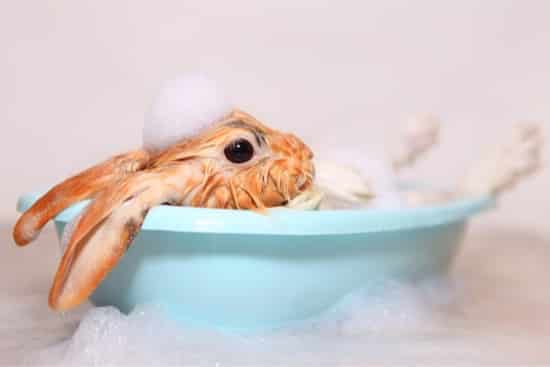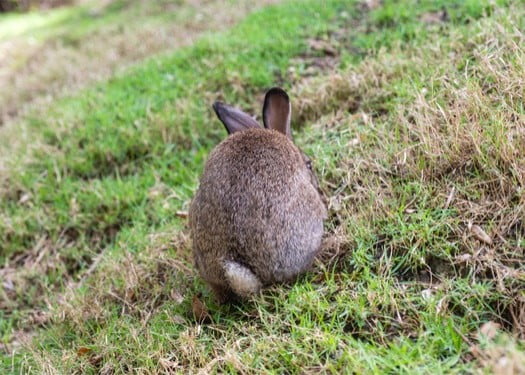Rabbits are fastidious groomers, but they’ll need assistance with cleaning on occasion. Their bottom is the area most likely to require human intervention. Fecal matter can cling to a rabbit’s bum, and that’s not just unsightly. It’s hazardous to their health.
If there is some dried poop on your rabbit’s bottom trapped, perform a dry wash. This involves rubbing cornstarch into the fur, and brushing out any lingering feces. A particularly messy rabbit’s rear end needs to be cleaned carefully in a sink of warm water and shampoo.
Keeping a rabbit’s bum clean is a critical part of its care. A rabbit with a messy bottom is at risk of flystrike, which is a very unpleasant disease. An unhygienic rear is also a sign of poor diet or an inappropriate lifestyle. These issues must be managed to prevent them from becoming more severe.
Are Rabbits Clean Animals?
Rabbits clean themselves constantly. If you have two bonded rabbits in your family, they’ll be even cleaner. Bunnies show their affection for each other by grooming.
As a result, rabbits are rarely dirty. Their fur should not smell, and always be glossy. The one exception to this can be their bum.
It’s possible that your rabbit will have a dirty bottom after eliminating. This is something that must be managed carefully. A soiled rear end can lead to health problems for rabbits.
How to Keep a Rabbit’s Bum Clean
If your rabbit does have a dirty bottom, something is amiss with their diet or lifestyle.
Before worrying about why, get your rabbit clean. If you’re wondering how to get poop off a rabbit’s bum, you have two options. You can use a dry cleaning technique, or a wet cleaning process.
How to Hold a Rabbit to Clean its Bum
A critical element of cleaning a rabbit’s bottom is how you hold them. Many rabbits will resist a butt wash, especially if it involves a bath. To hold your rabbit while cleaning them, follow these steps:
- Pick up your rabbit and get them used to being handled. Pet them until they’re calm.
- Rest your rabbit’s back against your chest. Be firm so they can’t wriggle away. Don’t hold on so hard they’ll hurt themselves, though.
- Place one hand under your rabbit’s front legs, against their chest.
- Support their bottom with the other.
Once you have your rabbit in position, you can start the cleaning process. Make this as short as you can, as your bunny won’t enjoy it. Just ensure that you’re thorough.
How to Dry Clean Poop from a Rabbit’s Bottom
If your rabbit’s bottom is only a little dirty, you can get away with a dry wash. This will not work if your rabbit’s bottom is coated with wet or damp feces. Only attempt a dry wash if you spot a handful of flecks. To dry clean a rabbit’s bottom:
- Rub a substantial amount of unscented cornstarch flour across their bum. Don’t use a product that contains talc.
- Rub the powder all over your rabbit’s bottom, and let it sink into the fur. This will loosen any dry feces.
- Take a wide-toothed comb, ideally without metal teeth, and brush out the poop.
- Pat your rabbit’s bottom with a soft towel.
If this does the trick, there is no need to take any further action. If the stains are stubborn, you’ll need to perform a wet wash.

How to Wet Clean Poop from a Rabbit’s Bottom
Most rabbits will resist being bathed. Unfortunately, it’s necessary if they have a dirty bum that cannot be cleaned with powder. To wash your rabbit’s rear:
- Fill a basin or bowl with 3 inches of warm water. Warm is the operative word. Never use hot water, as this will hurt your rabbit’s skin.
- Mix a tablespoon of rabbit shampoo into the water. Never use human shampoo, or that designed for other animals.
- Lower your rabbit into the water. Massage the dirty fur, ensuring it gets a thorough clean.
- The water will likely get dirty. Pour it away, and repeat the above steps. Keep doing this until your rabbit is clean.
- Towel dry your bunny. If necessary, use a blow dryer on very low heat.
You will not want to repeat this process this too often. It’s important that you understand why your rabbit has a dirty bum. You can then take action to avoid it happening again.
Why Would a Rabbit Have a Dirty Bottom?
A happy, healthy bunny will have a clean bum. Rabbits are so meticulous in their cleaning they even eat their fecal matter.
Rabbits typically produce two types of poop, as the Rabbit Welfare Association explains.
- Common pellets are the droppings that you’ll find in your bunny’s cage. These should be the size of a dime and odorless. They crumble if squeezed.
- Cecotrophs, or cecal pellets, are softer and slimier. Rabbits eat these from their fur, as they’re filled with nutrition. Cecotrophs are referred to as ‘night feces,’ as rabbits prefer eating them in the privacy of darkness.
If you spot a dirty bottom on your bunny, you’ll need to step in. A rabbit will only fail to clean cecotrophs from their bum if they’re unable. Reasons for this could include:
- Poor Diet
- Limited Mobility
- Obesity
Once you have found an explanation for your rabbit’s inability to clean themselves, take action. A dirty bottom is dangerous to bunnies.
How Can I Improve My Rabbit’s Diet?
Providing your bunny with a healthy, balanced diet is essential. It doesn’t take much to knock a rabbit’s digestive tract off course. There are three main components to a rabbit’s diet:
- Feed a small handful of high-quality pellets each day.
- Hay or straw. This should provide 90% of your pet’s diet.
- Fresh vegetables and leafy greens. Use these sparingly, as too much veg upsets a rabbits’ stomach.
Pellets are used to stabilize your bunny’s weight and energy levels. Pellets should contain a minimum of 18% fiber, and be as fresh as possible.
Young rabbits below seven months require unlimited pellets. Once a rabbit reaches maturity, reduce the daily serving. One eggcup per 6 lbs. of weight is ideal.
A healthy adult rabbit should gain the majority of their calories from hay. Use high-quality timothy, grass or oat hay, or a combination of the three. A pile of hay the size of your rabbit is sufficient. Replace this daily.
Vegetables should be kept as a treat, especially starchy root veg such as carrots. Stick with leafy greens where possible. Two tablespoons of vegetables per 6 lbs. of body weight is more than enough.
If you stick to these feeding guidelines, your bunny will enjoy healthy digestion. This will be reflected in their poop.
A rabbit producing more cecotrophs than they eat is consuming too many carbohydrates. A messy bottom will be the result.
How Do I Know if My Rabbit is Struggling with Mobility?
When a rabbit is in pain, they hide it convincingly. As prey animals, bunnies do not want predators to consider them easy pickings.
Arthritis is common in bunnies. This may be an inevitable result of aging. As PetMD explains though, rabbits also develop septic arthritis through bacterial infection.
If your rabbit is arthritic, they will lose the flexibility required to clean their rear. They’ll scoot around their cage, attempting to remove cecotrophs. Your bunny will then eat them from the ground.
Over-the-counter supplements and specialist foods are available for arthritic rabbits. Check your local pet store. These will ease pain, and increase mobility.
You may also wish to ease your bunny’s discomfort with a massage. Disabled Rabbits provides insight into how to do this.
A physical injury also limits a rabbit’s mobility. Hind leg injuries significantly reduce a rabbit’s agility. In such cases, manually remove cecotrophs from your bunny’s bottom. They need the nutrition provided by eating them.
As long as bunnies remain unable to clean their bottom, you’ll need to help. Scooting will only achieve so much. Daily cleaning will be required, at least until your rabbit regains their flexibility.

How Can I Help My Rabbit Lose Weight?
Rabbits that are overfed and under-exercised will gain weight. An obese rabbit will not be able to reach its bottom to clean it.
The Pet Food Manufacturer’s Association has a guide to understanding a rabbit’s ideal weight. Don’t just rely on your eyes.
To encourage weight loss in rabbits through diet, focus on feeding them hay. Reduce the number of pellets that your bunny eats. Minimize fresh vegetables, and avoid sugary fruit.
You’ll also need to encourage your rabbit to exercise more. Most bunnies love to run and play. Motivation drops when they become obese though. Exercise feels too much like hard works for a fat rabbit.
Learn what motivates your pet and increase their exercise regime. Toys and games will typically do this.
Once your rabbit starts dropping weight, they’ll be more interested in exercise. This will also restore their flexibility, and will be able to clean themselves again.
What Happens if I Don’t Clean My Rabbit’s Bum?
If the fur around your rabbit’s bottom is matted, it’s usually due to undigested cecotrophs. This can be hazardous to your bunny’s health.
Uneaten cecotrophs will cling to the fur around your rabbit’s bottom. This leads to the skin becoming cracked, and potentially infected.
If your rabbit’s bottom is coated with cecotrophs, wash it using the techniques we previously outlined. Be gentle, so as not to chap or damage the delicate skin.
If the area becomes infected, you should apply an antibacterial cream. Check your local pet store for such a treatment.
In many respects, cracked skin is the least of your rabbit’s concerns though. A dirty bottom can lead to a fatal condition called flystrike.
What is Flystrike?
Flystrike is the bane of a bunny’s life. This medical condition arises when wet cecotrophs cling to a rabbit’s bum. These attract bluebottles and greenbottles, who sustain themselves on animal feces.
While eating, these flies will lay eggs within your rabbit’s fur. These eggs, in turn, hatch maggots. These maggots eat the dead skin around your bunny’s bottom.
Eventually, they’ll run out of dead skin cells. The maggots then start to eat healthy skin. Flystrike consists of maggots eating your rabbit to death.
This is a horrific thing to happen to your bunny. As a result, it’s critical that their bottom remains unsoiled. Check regularly, and aid with cleaning if necessary.
How is Flystrike Treated?
Flystrike can only be treated by a healthcare professional. If you see flies or maggots in your bunny’s hutch, race them to the vet.
Don’t even stop to clean up first. Time is of the essence. Call ahead, and confirm that your rabbit will be treated as an emergency patient.
Your vet will administer an anesthetic and remove the maggots using tweezers. This should not be attempted at home. Maggots are stubborn, so an experienced hand is required.
Once the maggot infestation is removed, your rabbit’s bottom fur will be shaved. A vet will then prescribe antibiotics and painkillers to aid recovery.
How Can Flystrike be Avoided?
The only way to avoid flystrike is by keeping your bunny’s bum and hutch clean. If flies have no feces to eat, they’ll look elsewhere.
Feeding your rabbit a high-quality diet is the first step. This will ensure a healthy digestive tract. If your rabbit cannot clean themselves, be vigilant about helping.
Check on your rabbit twice a day, ensuring they’re clean. Their bottom should be spotless first-thing in the morning. Bunnies like to eat cecotrophs at night.
Regularly remove poop pellets from your rabbit’s hutch, too. Bunnies occasionally eat these, but not often. They lack the nutrition of cecotrophs.
Finally, apply screens around your rabbit’s home to keep flies out. This is especially important in the summer. Flies are commonplace in warm weather.
While rabbits are clean animals, they’ll need help cleaning their bottom from time to time. By now, you will realize just how essential this is.
If your rabbit eats well and exercises regularly, they should avoid issues with their digestion. That’s no reason to be complacent, though. You should still regularly check your bunny’s bum.
Don’t sleep on a dirty bottom in your rabbit. It’s simply not worth the risk. The few minutes it takes to clean them can be the difference between life and death.

